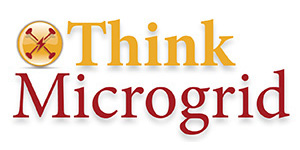Think Microgrid, an industry coalition formed in 2021 to support the adoption of microgrid technology, held its second Microgrid Policy Summit in May of 2023. During the summit, more than 100 experts from across the microgrid industry, government, academia and the advocacy community explored policy hurdles slowing microgrid development. Microgrid News spoke with Cameron Brooks, Think Microgrid’s executive director, about the policy and technical challenges facing microgrids today and the evolving solutions to meet them.
There’s a new sense of urgency around developing renewable energy microgrids, which are a crucial ingredient in the transition to a fossil fuel-free energy economy. The passage of the U.S. Inflation Reduction Act (IRA) in 2022 provides financial incentives for microgrid components and microgrids using renewable energy resources, but challenges remain in existing policies and regulations.

Organizers of the 2023 Microgrid Policy Summit aimed to examine policies that limit the timely adoption of microgrids. According to Think Microgrid Executive Director Cameron Brooks, these paradoxes — or contradictory policies — are rooted in legacy business models and regulations originally developed to serve a fossil fuel-dependent energy infrastructure. The current energy system relies on centralized power plants and the tightly regulated utility companies that operate them, controlling and sometimes inhibiting the development of new technologies. For many years, utility companies opposed systems that could be “islanded” or isolated from the grid, fearing safety issues and loss of control over their distribution systems. They also feared the financial impacts of what was referred to as grid defection.
Brooks said that as we transition to a decentralized energy system based on renewable energy, we need to resolve policy contradictions between the old system and the new. He believes this change will present opportunities to create resilience, job possibilities and greater energy equity while spurring technical innovation.
“This was the best policy summit I have attended on the subject,” said Peter Lilienthal, global microgrid lead with UL Solutions and creator of HOMER software. “Think Microgrid is playing an important role in educating industry and policymakers on the potential for microgrids to accelerate the clean energy transition in a sustainable and resilient way.”

We spoke to Cameron Brooks following the Think Microgrid Policy Summit to learn more about policy challenges and solutions.
Cameron, thank you for providing us with this update on the Think Microgrid Policy Summit. Could you describe the most critical barriers to advancing microgrid development?
Brooks: We’ve identified five critical areas where we need to resolve important policy issues.
- First are bans on gas service. We believe natural gas can be an important tool in helping the transition to an energy system based on renewables, particularly in residential and small business settings. We should adopt a phased approach to ending our reliance on natural gas to use an optimal combination of generation resources as we move towards the lowest possible carbon emissions.
- Second are delays in upgrading utility distribution infrastructure. We need to remove the regulatory and technical constraints in upgrading grid infrastructure, even if that means letting private investors into an area that has traditionally been the purview of utilities. This would mean allowing third parties to finance and benefit from upgrades to the distribution system in situations where utilities are unwilling or unable to do so.
- Barriers to multi-customer microgrid development are the third concern. Community microgrids are functionally illegal in most jurisdictions. This is mainly because of past regulations designed to support utility companies in return for providing public services. We should define new qualifications necessary for private enterprises to operate microgrids and participate in energy markets, especially in situations where resiliency is an urgent priority.
- The fourth point to consider is the establishment of fair value for microgrid exports. For microgrids to be financially viable for private investors, they need access to bulk power markets. The investors need a fair price for the energy the microgrid feeds back to the grid and the resilience and grid stabilization services they provide. Utilities also need financial incentives to build microgrids, and new regulations could provide incentives.
- The fifth issue is the prompt and equitable distribution of public funds. , public funds should prioritize underserved communities and targeted improvements in grid infrastructure that enable distributed renewable energy development in underserved areas.
Can you talk about the impact of bans on natural gas taking place, particularly in California?
Right now, we don’t have widespread technology to support renewably powered resilience on a multi-day basis. We don’t want to see more backup diesel or gas implemented because those systems cause pollution. What is happening in some places is that marginal carbon emissions are going up if there are contracts for out-of-state bulk power with a higher emissions profile. Rather than outright bans, a phased approach to ending our dependence on natural gas should result in lower emissions.
What is the most important factor that could impact improvements to the grid distribution system?
We need to take both a carrot and stick approach in regulating utilities. It’s important that utility profits connect to the value they can produce for their customers. That doesn’t preclude the ability of customers to make choices. Private and public capital resources stand ready to invest in developing microgrids that will create value, and they should be allowed to make those investments.
Regarding the need for distribution upgrades, there have been a lot of stories recently about massive interconnection delays for both large and small renewable projects. What is the solution to this?
I think the first step is transparency. In each situation, we should know what is causing these delays, whether for technical reasons or whether there is resistance to distributed energy because it’s potentially a threat to utility profits. What we do know is that microgrids can help solve grid congestion and provide a counterweight to the uncertainty of intermittent renewable energy production. In short, microgrids can provide services that allow utilities to delay expensive upgrades to grid infrastructure. As the demand for EV charging surges, it will be even more crucial to use distributed energy microgrids to produce electricity and help manage our evolving grid.
What other critical policy changes are you proposing? You mentioned community microgrids and fair value for microgrid services.
We urgently need to eliminate the legal barriers that prevent anyone except a utility from serving multiple customers. This is an outdated concept that is preventing communities from developing resilient solutions to climate change. To the extent that community microgrids address the needs of underserved populations, we need to target infrastructure upgrades to these areas and ensure they can take advantage of recent legislation that provides financing for clean energy projects.
Finally, intelligent, interconnected microgrids provide a wide range of value streams to retail and wholesale markets. But so far, we do not have policies allowing owners or investors to capture that value. Microgrids can provide resilient, clean energy production that responds to the demands of a new energy-hungry electrified transportation system and the grid services previously mentioned. We also need an open-access framework that allows microgrids to benefit from lucrative power markets.
In some states, we already see efforts to address these policy issues. I’m confident that as more people learn about the merits of microgrids, we will collectively recognize the urgency of eliminating barriers to their development.
Learn More
Explore Think Microgrid’s work in advancing the adoption of microgrid technology.

UL Solutions HOMER Grid is a market-leading solar-plus-storage software tool for designing grid-tied distributed energy systems. With an integrated utility tariff database and a new module for electric vehicle charging stations, it optimizes peak shaving to help commercial and industrial utility customers lower their demand charges. HOMER Grid can model projects with wind and combined heat and power as well as islanded systems, helping users improve their resiliency. Explore your opportunities with HOMER Grid during a complimentary trial. Learn more and download your complimentary trial.
